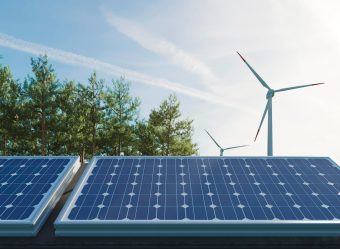
Worldwide employment in renewable energy reached 13.7 million in 2022, an increase of one million since 2021 and up from a total of 7.3 million in 2012, according to a new report by the International Renewable Energy Agency (IRENA) and the International Labour Organization (ILO). The tenth edition of Renewable Energy and Jobs: Annual Review 2023, is the product of a continuing collaboration between the two agencies.
The report found that renewable energy is attracting increasing investment, leading to job creation in a growing number of countries. However, as in previous years, most of the jobs are concentrated in a few states, notably China, which accounts for 41 per cent of the global total. Brazil, European Union (EU) countries, India and the United States of America (USA) were among the others. Together they represent the majority of global capacity installations and play key roles in the manufacturing of equipment, engineering and associated services.
Solar photovoltaics (PV) was once again the largest employer in 2022, the Annual Review found, reaching 4.9 million jobs, more than a third of the total workforce in the renewable energy sector. Hydropower and biofuels had similar numbers of jobs as in 2021, around 2.5 million each, followed by wind power with 1.4 million jobs.
More:
- IEA, ECB AND EIB HIGHLIGHT IMPORTANCE OF AN ACCELERATED CLEAN ENERGY TRANSITION FOR EUROPE’S INDUSTRIAL COMPETITIVENESS AND FINANCIAL STABILITY
- STEPPING UP IN RENEWABLES TOWARDS ENERGY STABILITY
- UPCOMING EU HYDROGEN BANK PILOT AUCTION: EUROPEAN COMMISSION PUBLISHES TERMS & CONDITIONS
Francesco La Camera, IRENA Director-General, observed that “2022 was another outstanding year for renewable energy jobs, amid multiplying challenges. Creating many more millions of jobs will require a much faster pace of investments in energy transition technologies. Earlier this month, the G20 leaders agreed to accelerate efforts to triple global renewables capacity by 2030 aligned with our recommendations ahead of COP28. I call on all policy makers to use this momentum as an opportunity to adopt ambitious policies that drive the needed systemic change.”

ILO Director-General, Gilbert F. Houngbo, said, “To seize the significant opportunities to attain full, productive and freely chosen employment, social inclusion and decent work for all during these complex transitions, there is a need to develop and implement specific policies for inclusive macroeconomic growth, sustainable enterprises, skills development, other active labour market interventions, social protection, occupational safety and health and other rights at work, and find new solutions through social dialogue.”
The quality of jobs matters as much as their quantity, the study notes. To advance social justice, the transition to a cleaner energy future needs to be just and inclusive for all; workers, enterprises and communities. Hence, coherent and integrated frameworks are indispensable, with a focus on wages, occupational safety and health and rights at work, and based on effective social dialogue. The ILO’s Guidelines for a just transition towards environmentally sustainable economies and societies provide a central reference for policy making and actions to support a just transition that governments and other stakeholders can draw upon.
A just and inclusive energy transition must also pursue workforce development and diversity. The report highlights the need to expand education and training and increase career opportunities for youth, minorities and marginalised groups. Greater gender equity is also essential. At the moment, jobs in renewables remain unequally distributed between men and women. Currently, solar technology has the best gender balance compared to other sectors, with 40 per cent of jobs held by women.
Many countries are showing increased interest in localising supply chains and creating jobs domestically, with support from appropriate industrial policies. This goes hand-in-hand with a growing desire to lessen energy supply insecurities. China has successfully pursued a broad array of these industrial policies for some years. More recently, the EU, India, Japan, South Africa and the USA have announced initiatives to stimulate domestic manufacturing. However, countries will need to find ways to combine localisation efforts with continued global cooperation in pursuit of an ambitious energy transition.
Source: IRENA



